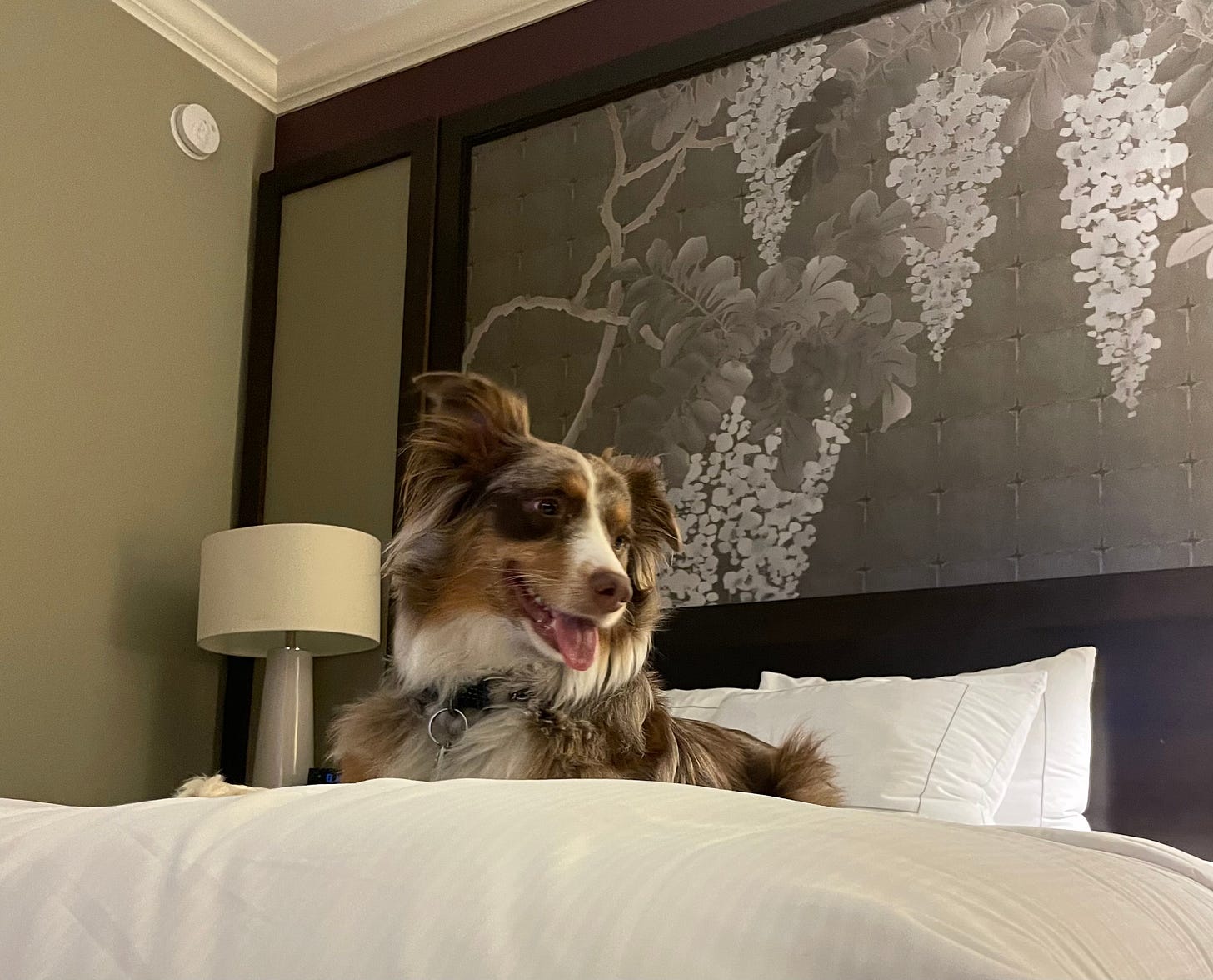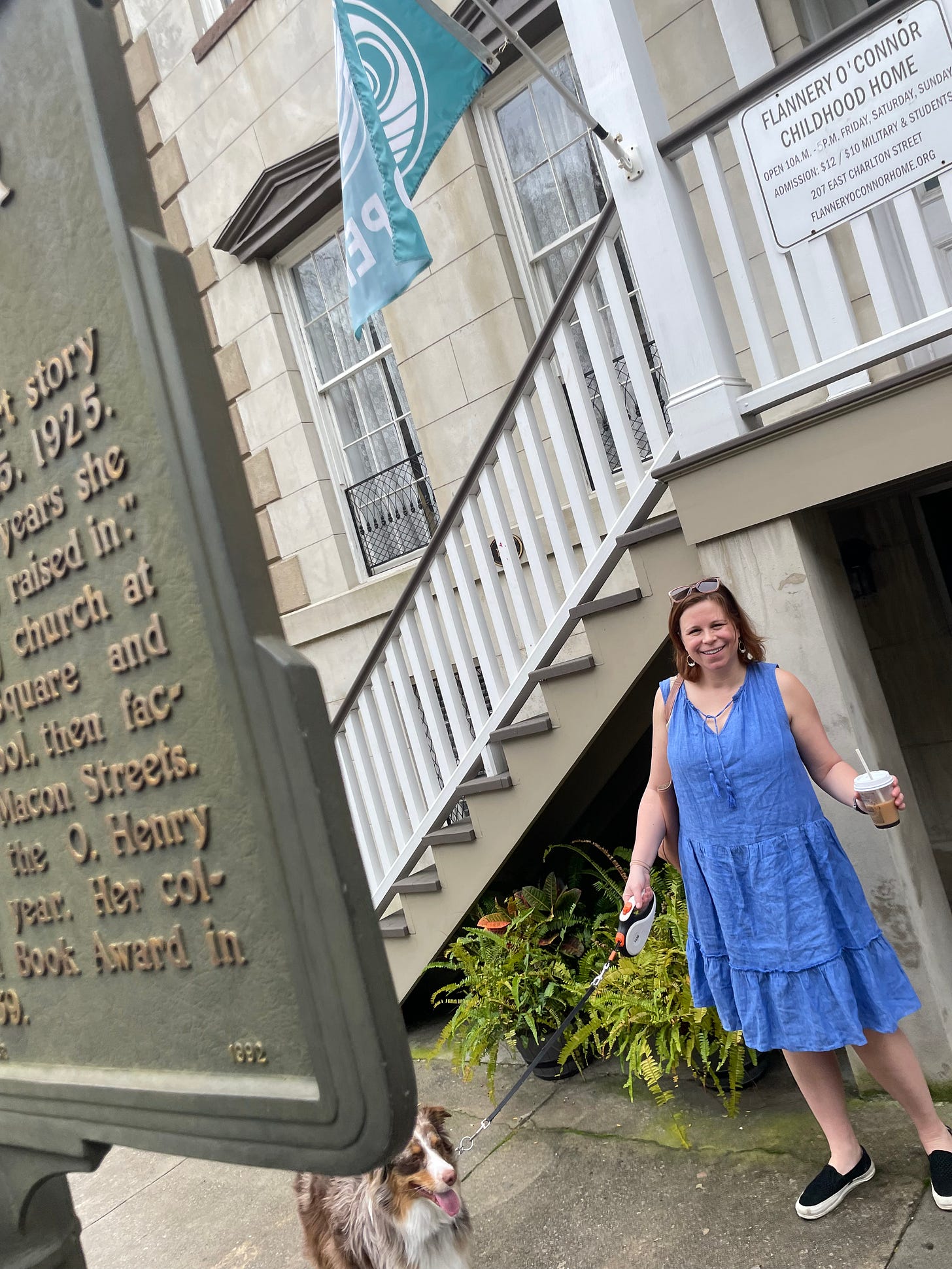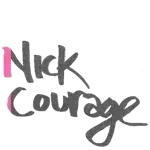Writing Without a Mind's Eye (+ More!)
Plus: Eloise at the Plaza, Bookstore Cats, Flannery O'Connor, The Childhood Bird™, The Most "Difficult" Author, Winter Road Trips...
Every once in a while, I’ll see a post about “aphantasia” and just the thought of it takes over my life for a couple of days. A negation of the Greek word phantasia (or imagination), aphantasia literally means “without imagination.” More specifically, it’s a rare-ish “inability to create mental imagery.”
This is Nick’s personal (and definitely not professional) newsletter—for Courage Literary agency news and updates, visit courageliterary.com!

I recently started thinking about aphantasia again because of a viral tweet by the author John Green. He’s a five on the scale pictured above… and so am I. Up until a few years ago, when someone told me to “visualize whirled peas” (or anything, really), I thought “visualize” was shorthand for “think about” or “consider.”
I didn’t know that most people could literally form a picture in their heads.
Which is annoying, because I’ve always heard about readers who have such vivid visual imaginations that they lose track of the words in the books they’re reading—that the images just start to take over, like a movie—and not only do I not have that, but (knowing that lots of people do) I have such a profound sense of missing out.
Like the rest of the world has just been living with this super power that I didn’t even know about until I was in my thirties.

It’s easy to get tripped up when you start thinking about thinking… but when I close my eyes, I see the backs of my eyelids—and when I try to visualize something, I have an interior monologue that describes both the visualization and my act of visualizing: “I’m picturing an apple,” for example, or “I remember dust floating through a beam of light when I was three years old and the radio was playing jazz.”
There’s no picture, just words.
It’s funny, how much these little biological quirks can affect how we live and experience the world. I was on a long car trip with with Rachel this week and we started talking about memories and how we access them… and our brains work so differently that I started to feel reality start to wobble a little bit as we talked.
But sometimes not having a superpower is a kind of superpower.
Kids always ask about how I make my books feel like movies, and I talk a lot about “pre-writing” in workshops (developing all your characters and settings before you sit down to write so they feel more vivid and lived-in on the page). But it was only after this most recent fascination with aphantasia that it really clicked for me: I might not have any images in my head, but I have a lot of words to compensate for that.
It’s all descriptive up there; it’s all narration!
Google says that less than one percent of the world are full aphantasics, but I wonder if that percentage is higher for writers? (So far, I just know about me and John Green!)
Also interesting: I recently found out that aphantasia has an opposite—hyperphantasia—and it’s associated with synesthesia (“some examples include tasting words or linking colors to numbers and letters”).
I’m on the road with Rachel this week, on a last minute trip for a little book research.
We drove all the way down to Miami from Pittsburgh, stopping in a few bookstores for “stock signings” along the way—which just means I signed copies without doing a full event, which would have been harder to manage on our schedule. The picture above is from Flannery O’Connor’s childhood home in Georgia, which is right around the corner from E. Shaver’s Books (the oldest bookstore in Savannah).
Flannery lived here until she was thirteen, so she would’ve been the age of my readers when she was living here—which is one of the best parts about writing for kids, knowing that your readers are going to grow up and make their marks on the world.
We were traveling with Chaely and couldn’t take the tour of Flannery’s house, but I’d heard that her childhood bookshelf was preserved so I tracked down pictures of her shelves as soon as we were back in the hotel.

“Not a very good book,” she’d written on the title page of The Fairy Babies—which made me smile, reminding me of when I took my old “Writing Youth Literature” class on a field trip to the special collections at the University of Pittsburgh to visit the manuscript of the Mixed-Up Files of Mrs. Basil E. Frankweiler (and other kid lit treasures)… and of some of the archival photos I got to flip through when I was working on her Prayer Journal at Farrar, Straus and Giroux.
Below is an animated screen grab from a now-defunct website we’d made called FindFlannery.com, a sort of Where’s Waldo for her trademark scowl:

Also in Georgia was this tortoise, who we saw walking around a park by the bookstore like he owned the place. Talk about experiencing the world a little differently: tortoises live so long that the late conservationist Steve Irwin may have been the caretaker of a tortoise that Charles Darwin collected on his survey expeditions. Her name was Harriet and she lived to be around 250 years old.
We were told this guy’s name is Robert.
This big trip south marked Chaely’s first time staying in an actual hotel—and except for the elevators, she seemed to really love it. So much so that she reminded me a little bit of Eloise at the Plaza… who I can’t think about anymore without also remembering a short and bittersweet documentary about Hilary Knight and his complicated relationship with Kay Thompson, the reportedly mercurial author of the Eloise books (It's Me, Hilary: The Man Who Drew Eloise).

Eloise has been on my mind kind of a lot lately, for two reasons beyond that documentary (which did—admittedly—get the ball rolling):
1) The Plaza is one of the few hotels in New York that allows dogs of all sizes (most dog-friendly hotels cap their friendliness at thirty pounds, but the concierge at the Plaza is out there giving big dogs their own terrycloth robes!):
“A haven for pampered pooches since 1907, The Plaza Hotel has known countless doggie residents such as Timothy the English springer spaniel of the Hollywood Columnist E.V. Durling; to Mrs. Montis of Paris’ three Chihuahuas” (LIFE magazine, Nov. 18th 1946).
O, to be a Kid Lit Author in Residence™ at the Plaza Hotel!
2) A few weeks ago, Rachel and I zoomed into a book talk by John Sargent—our old boss, the former CEO of Macmillan—that was hosted by the New York Society Library in celebration of his recently published memoir (Turning Pages: The Adventures and Misadventures of a Publisher).
John’s grandfather was Frank Doubleday (the founder of the Doubleday publishing house, if the name didn’t give it away!), so a lot of his talk was about how much publishing and “author care” and development has changed since the late 1800s—with lots of stories from his grandfather’s diaries about his friendships with people like Andrew Carnegie and Rudyard Kipling and Mark Twain.
I love a good publishing history (also on my recent to-read list: Scribners: Five Generations in Publishing ) so I could listen to that kind of stuff all day.
But back to Eloise: during the Q&A, someone asked John if one author in his career stood out as the most “difficult” to work with. He’s worked with so many big name authors and celebrities and it’s not the nicest question in the world, so I was sure he’d find a way to deflect—to not name names. But (quickly and without a lot of explanation) he just said “Kay Thompson, the author of the Eloise books.”
Which, for what it’s worth, is really saying something!
So now I have another publishing-adjacent biography on my to-read list—Kay Thompson: From ‘Funny Face’ to ‘Eloise’ by Sam Irvin. And if you click that link, scroll down for a quick but memorable illustration of how much children’s publishing has changed over the years: apparently “Eloise kept a bottle of gin in her bedroom”!
Anyway, I’m writing this email from south Florida, which is a place that brings up a bunch of text-based memories (aphantasia callback!) for me.
I graduated from the University of Florida “up north”—incidentally, there are kind of a lot of us Gators in publishing!—but most of my extended family lived in Miami when I was growing up: my grandmother and great uncles and aunts and cousins (real and in quotation marks). Miami was where my relatives moved after they immigrated to New York, so that’s where we’d go on vacations.
There’s something really centering about being back in a childhood landbase, surrounded by the trees and smells and sounds you grew up with.
I thought about that a lot when I was writing The Loudness and Storm Blown, both set in my home town of New Orleans. A big part of writing, for me, is putting myself back in that 8 to 12 year old mindset and geography can be the perfect shortcut to getting there. This might be a thought for another email, but whenever I start thinking about this kind of stuff, I always remember a TikTok I saw (and forgot to save) of an adult man filming himself hearing a mourning dove and… was he crying or smiling?
Either way, the caption just said “it’s the childhood bird!”
On this trip, I’m not time-traveling back to childhood so much as visiting bookstores and libraries with Rachel (and driving from dog beach to dog beach along the way).
So, if you’re in Lake Worth or Palm Beach or Miami or Savannah or Charlotte—and all points in between—check your local bookstores and Little Free Libraries because we’re coming through town and leaving signed books wherever we go!
Until next time,
Your friend,
“These thrilling stories feature ordinary kids — just like the reader — who, when faced with extraordinary challenges, have to use all of their courage, ingenuity, and determination to fight for their lives and the lives of those around them!”
—A Mighty Girl
P.S. Thanks to A Mighty Girl for including Snow Struck in their list of 25 Mighty Girl Survival Stories! More book news from me soon…







